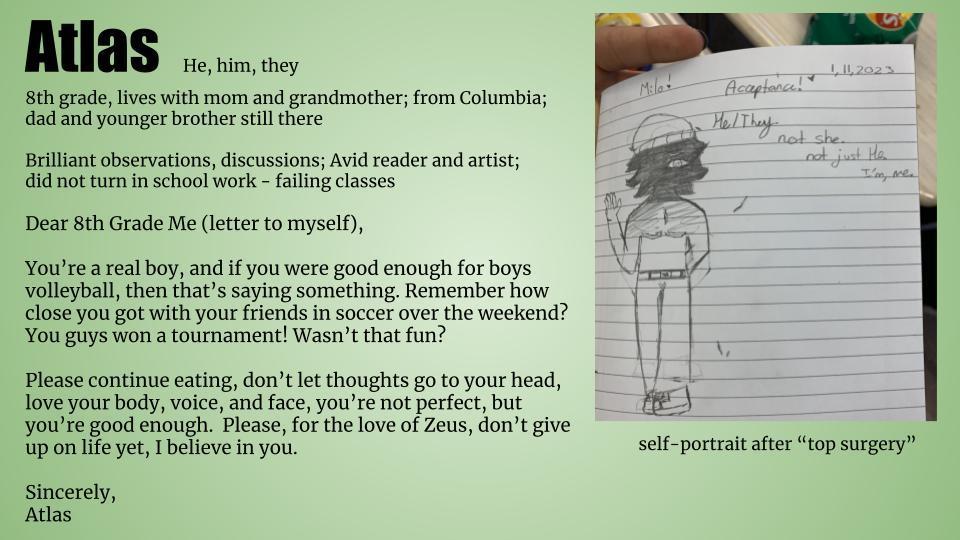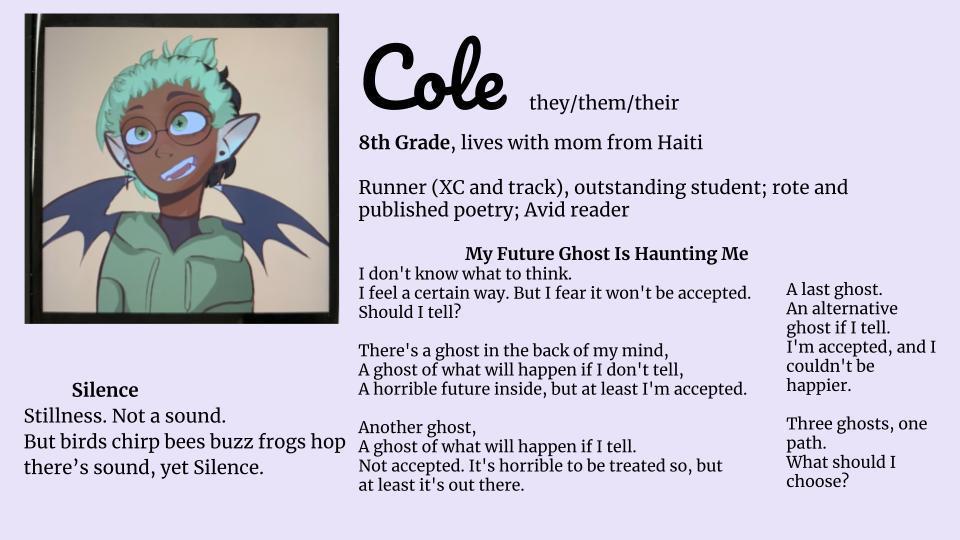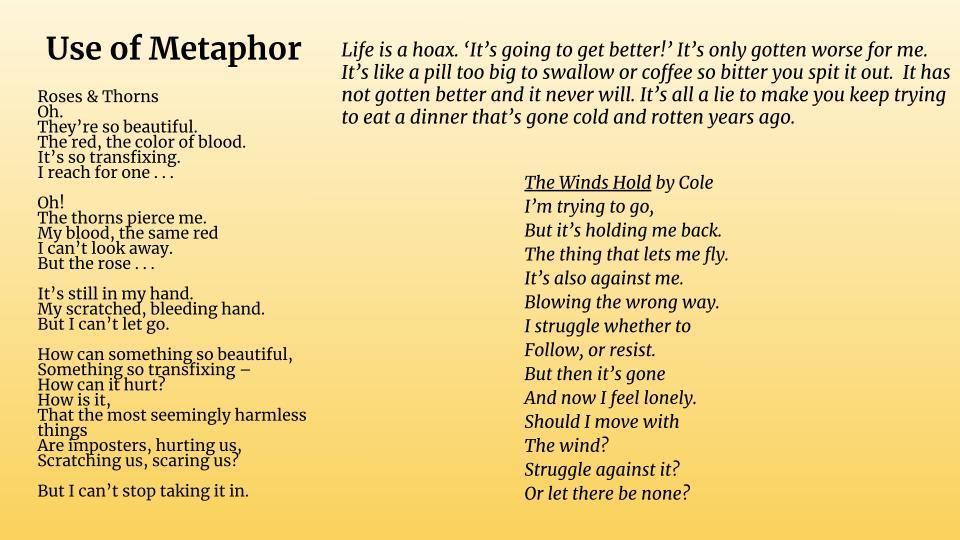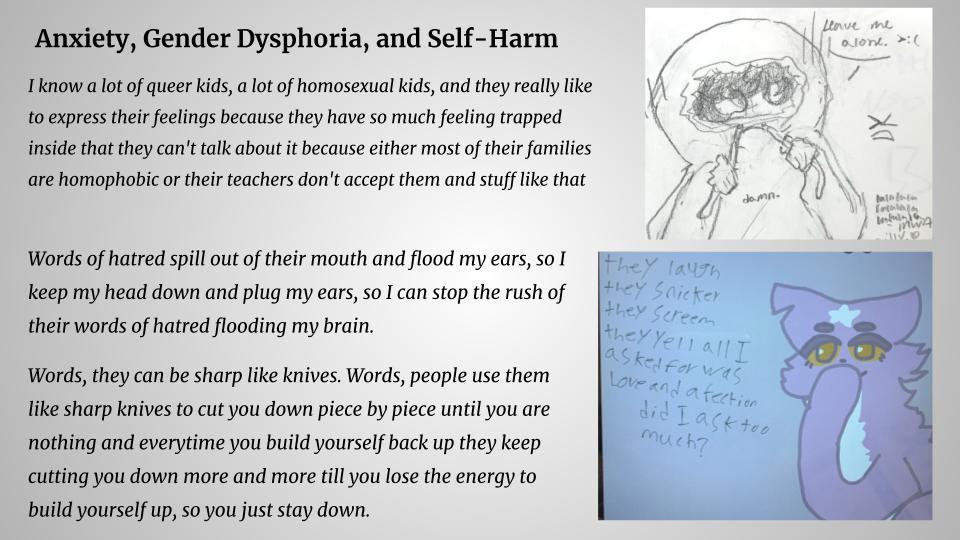
ANAFTER-SCHOOL, LITERACY-BASED, MIDDLE SCHOOLGSA
Elizabeth
Gennosa
Hofstra University Literacy Studies Department of Specialized Programs in Education
Methodology:Action Research & Ethnography
Action Research - Practitioner Research
Action research focuses on challenging normative school practices and working as an agent for social justice, requiring a continuous process of data gathering, analysis, and action (Cochran-Smith & Lytle, 2009).
It invites the students to provide feedback and direction and strives to benefit the well-being of the students. It is socially responsive, addressing injustice and outlining best practices for other schools (Cochran-Smith & Lytle, 2009; Stringer, 2008; Hine, 2013; Johnson, 2008; Kemmis, 1988, Mills, 2011).
Inclusive Practices for Social Justice
Read from a diverse library, discuss censorship and social justice, practice a critical stance, disrupt the norms, and explore perspectives. (Page, 2016; Herman-Wilmarth et al., 2017; Ervin, 2022; Paris, 2021; Batchelor et al., 2018; Ladson-Billings, 1995; McGarry, 2022)
their identity.
Social Justice: Literacy has the power to challenge existing structures.
(Gee. 2000, 2004; Gee & Gee, 2007; Gee & Green, 1998; Heath & Street, 2008; Robinson, 1999; Moje & Luke, 2009; Mishler, 2004; Blackburn, 2003)
Queer Theory and the Queer Literacy Framework
Stance: rejects the labeling, binaries, and categories that often define us
Origins: founded on theorists such as Foucault (1990), who rejected the ideas of binaries contrasting dominant and subservient counterparts that uphold societal power structures
(Jagose, 1996; Butler, 1994; de Lauretis, 1991)
Supportive Mindset Queer Literacy Framework: Miller’s (2015) QLF establishes “non-negotiables”
1. Do not presume that students are heterosexual or gendered.
2. Recognize that gender is a construct.
3. Understand that gender norms assign masculine or feminine traits for us to perform.
4. Acknowledge that gender and sexuality are fluid.
5. Allow students to self-define with chosen names and pronouns.
6. Examine and critique gender norms in society, literature, and the media.
7. Understand that adhering to normative expectations sustains and reinforces violence and oppression.
8. Acknowledge the intersectionality of other identities that create our beliefs and actions.
9. Be an advocate for equity for all.
10. Believe that a safe environment is a right that all students deserve.
Book Selections: LGBTQIA+ themes or characters used in schools often present homonormativity, or a narrow view of this diverse community, often with characters who are “politically acceptable through race, class, gender, and other types of privilege”
(Hermann-Wilmarth and Ryan, 2016; Blackburn and Buckley, 2005)
Pedagogy: Page (2016, 2016b) queer theory is a lens through which students can discuss literature, examining how identities and relationships in the text and in society are created and either supported or rejected by the existing cultural framework.
Critical Literacy: Social JusticeAdvocacy
Page (2016b) emphasizes the importance of representation since “one of the greatest traumas that gender- and sexual-minority students experience is not bullying but invisibility and silence” (p. 678). Representation matters, yet many teachers express a reluctance to risk experiencing negative feedback from parents and administrators.
Adopting a critical literacy framework to address the needs of students while balancing the constraints of the curriculum is a positive step toward creating safer schools for LGBTQIA+ students (Janks, 2013).
Curwood and Jones (2022) also studied the effects that spoken word poetry workshops can have on marginalized youth, as it “can encourage marginalized youth to participate in



Provide safe spaces and time for journaling and discussion. Uplift students’identities with culturally sustaining pedagogy (Jaekel, 2017; Page, 2016; Herman-Wilmarth et al., 2017; Ervin, 2022; Paris, 2021; Batchelor et al., 2018; Ladson & Billings, 1995; McGarry, 2013; Wernick et al., 2021; Janks, 2013)
Data Collection -Triangulation of data to ensure validity (Johnson, 2008; Mills, 2011)
Artifacts Photos of students’writings and artwork; Video and audio recordings (Mills, 2011) Interviews Formal and informal. Individual and focus group interviews for shared understanding (Mills, 2011)
Observations Ethnographic, qualitative field notes written as a participant observer. Glesne (2011) defines the participant observer as one who “carefully observes, systematically experiences, and consciously records in detail the many aspects of a situation” while being conscious of one’s own personal bias in interpreting and analyzing p. 68).
DataAnalysis
Sociocultural lens and queer theory -examined language, literacy, and identity (Gee, 1991, 2004; Heath & Street, 2008; Moje & Luke, 2009; Locson, 2008; Foucoult, 1990; Jagose, 1996; Miller, 2015; Hermann-Wilmarth & Ryan, 2015; Jimenez, 2015)
reviewed each artifact.(over 150 pieces) and drew out patterns and themes (Merriam, 2009)
Context and Participants
Suburban NYMiddle School
● Large, public, suburban NYmiddle school
● 1,000 students
● 32% economically disadvantaged
● 38% non-White (NCES, 2022)
● politically conservative
The One World Club the GSA
● After-school, school-sponsored club
● 48 members in grades 6 - 8 who identify as LGBTQIA+
● Read diverse texts, shared writing and artwork in journals
● Met on Friday afternoons in school classroom and library
Structure of the Meetings
● Guided by Blackburn’s (2005) work with an out-of-school group of LGBTQIA+ youth
● Sign in with chosen name and gender
● Read aloud a short piece of culturally responsive literature
● 5 8 minutes of writing or drawing time
● Use a stage to perform an excerpt or poem.
Data Collection
Ethnographic notes written after each meeting
Interviews of selected students.
Artifacts After the journal sharing, students were given time to listen to socialize and relax in a supportive environment while circulated and talked to individual students about their writing and artwork, often asking to photograph samples.
Role of the Researcher simultaneously took on the role of teacher and researcher (Cochran-Smith & Lytle, 2009). was an active participant observer as primarily observed while interacting with the participants ( Mills, 2011). The







Conclusions/Implications

www.postersession.com IDENTITY, SOCIALJUSTICE,AND THE GAY-STRAIGHTALLIANCE: THE LITERACYPRACTICESAND IDENTITYCONSTRUCTIONS OF LGBTQIA+ STUDENTS
IN
Abstract This study provides a portrait of LGBTQIA+ youth who are provided a safe space after school to engage in critical literacy practices, develop skills in self-advocacy, construct their identities, and create a community. By reading culturally relevant literature and responding with multiple modes of literacy practices, including spoken word performances, students engage in the critical work of countering the positioning of others.These positions are often linked to power and ascribed through social structures such as gender, race, and class. Introduction GLSEN Survey - The Gay, Lesbian, & Straight Education Network (GLSEN) survey exposes multiple ways youth are misunderstood, underserved, harassed, and struggling in school. Despite this –10% decrease in GSAs in past few years(Kosciw et al, 2022). ● 81.8% feel unsafe ● 97% negative remarks ● 76% verbally abused ● 31% physical harassment ● 54% sexual harassment ● 78.8% avoid extracurriculars ● Lower self-esteem ● Higher depression ● Suicidal ideation Social Injustice ● biased remarks, victimization, discrimination ● unfair disciplinary practices at school ● absenteeism low rates of high school completion (Johns et al., 2021; Porta et al., 2017; Kosciw et al., 2013, 2022; Poteat et al., 2022). Intersectionality interconnectedness or overlapping of social categorizations ● Intersection of discrimination - multiple layers ● race, socioeconomic classification, cultural identities ● gender and sexual preference Jiménez (2021) urges teachers to consider an individual’s complex and intersecting aspects of their identity when selecting literature, rejecting the often relied-on binaries found in the literature. Safe Space - Gutiérrez (2008) defines this as theThird Space, which can be developed in schools to offer an environment “in which students begin to reconceive who they are and what they might be able to accomplish academically and beyond” (148). Blackburn (2005) describes a safe space as a “place brought to life (including) the people within a place and the ways in which that place brings people to life” (p. 19). Safe Spaces allow students to create, recreate, invent, and reinvent identities (Hatchel et al., 2019; Porta et al., 2017; Blackburn, 2021; Lapointe, 2016; Lessard et al., 2020; Poteat et al., 2016) Spoken Word Poetry ● develops voice and promotes advocacy ● Poetry tells the truth; it has a “maximum impact through the use of a minimal number of words, and it demands precision Poetry as a literacy practice and situated learning creates a space for critical thinking and dialogue” (Jocson, 2008). Jones and Curwood (2020) explored how aThird Space is created through engaging in spoken word poetry, where marginalized students are given a voice to write, recite, and respond to culturally relevant poetry and prose. This space allows students to use literacy to make sense of their worlds and futures, which Freire (1972) would refer to as naming their world and defining their place within it. By questioning dominant discourses, exchanging authentic voices and interpretations, and receiving affirming feedback, students begin to examine and interrogate the status quo found in schools, imagining a future in which they are prepared to advocate for social justice and freedom from oppression. After-School Clubs - spaces where students can construct or refine their identities. (Miller, 2015. 2019; Marx & Kettrey, 2016; Kosciw et al., 2013) Poetry Club - gave students a safe space to write, read aloud, and publish poetry and prose.The group asked for a GSA, so we created it together.This school-sponsored, after-school, literacy-based club is in its 3rd year. GSA Gay-StraightAlliance, or Gender-SexualityAlliance ● Advocacy ● Community ● Representation ● Creative Expression ● Identity Construction Youth Spaces and Literacy Performance ● Safe spaces in schools can be transformative ● Students engage with agency ● Students construct identity and increase self-esteem ● Out-of-school writing provides opportunities (Cytrynbaum, 2010; Fine & Weis, 2000; Weinstein, 2010; Vaughan, 2019) Research Questions How do students construct meaning and understanding as they read, discuss, and respond to literature and shared writings? How do literacy practices within the GSAcontribute to the youths’identity construction? How do the students view the role of the GSAin their lives and their sense of selves? Theoretical Framework Sociocultural Perspective of Literacy Empowerment: Literacy is a social practice and a means for identity creation and empowerment.
Construction: Identity is developed and shaped by our social constructs and surroundings, our position within these contexts, our constructs or imagination, and our descriptions or retelling of our constructs and identities. Identity is ever-changing. Students can “perform”
Identity
participants
this study were some of our school’s most vulnerable students.Action research relies on understanding the vulnerability of the participants and the importance of
in
LGBTQIA+ youth need safe spaces in schools. These students are experiencing an overwhelming amount of stress due to harassment and other forms of oppression. The writings and artistic creations provide evidence of what many surveys of LGBTQIA+ youth reveal, especially those who are additionally members of a marginalized group, such as race, ethnicity, or socioeconomic status. (Johns et al., 2021; Porta et al., 2017; Kosciw et al., 2013, 2022; Poteat et al., 2022). The GSAprovided a safe space to the youth to develop positive connections, advocacy skills, and identity construction. Connections Students connected to the characters and themes expressed in the literature, formed a sense of community with each other and gained a better understanding of their lived experiences. Advocacy - When given a safe space in school as a literacy-based GSA, students gain the confidence to rewrite the narrative presented in school. Students advocated by sharing their stories with the school through poetry performances. Identity Construction Through readings, journal writing, spoken word performances, artwork, and discussions, students constructed, rehearsed, shared, and revised their identities. The literacy practices shared in the GSAwere instrumental in identity construction and advocacy,the well-being of these students, as illustrated in Lana's poetry: Proud Show the world who you are Show them from afar Let them know who you are. Pride Don’t hide Don’t be afraid to show your pride Write, or your feelings will never be found Hidden in the moss Critical Literacy Pedagogy Students should learn to question existing power relations and examine how literacy can empower them to rewrite the narrative. Selecting LGBTQIA+ inclusive texts with diverse representation, educators can begin to address the inequities and challenges faced by LGBTQ students and seek to create social justice in the classroom and society. In the context of queer theory, creating more inclusive curricula disrupts the heteronormative social structures in schools (Lugg & Murphy, 2014; Jagose, 1996). Literacy is a social practice in which identity construction takes place. - The LGBTQIA+ youth’s identities are socially constructed and negotiated within and across literacy practices (Gee, 2004; Heath & Street, 2008; Robinson, 1999). Moje and Luke’s (2009) metaphor of identity as narrative helped me to understand how literacy and identity are closely tied as the participants wrote, revised, and rehearsed versions of their identities. This study contributes to the understanding of how a GSAin school can support LGBTQIA+ youth as they use literacy to disrupt the heteronormative power structure found in schools and society. This study advocates for educators to provide a safe space for students to see themselves positively represented in literature, to write about their experiences, to engage in discourse with peers as they construct their identities, and practice spoken word poetry to develop skills in advocacy. Aliteracy-based GSAcan provide a safe space, allowing LGBTQIA+ students to see themselves represented in literature, construct their identities, build a sense of community, and use critical literacy practices including spoken word poetry to advocate for themselves and for social justice for all students.
Case Studies: Portraits of LGBTQIA+Youth
Overarching Themes Expressed in Writing andArtwork
Overarching Themes Expressed in Writing andArtwork












